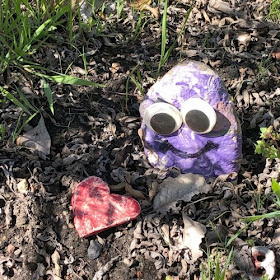I had this blog post planned over a
month ago, but just could not get into it so I put it off. But in these days of sheltering in place I
thought a virtual tour of a garden might be just the thing. I chose the Luther Burbank Home and Gardens.
March 7th was the birthday
American horticulturist Luther Burbank.
Born in 1849, he developed many new varieties
of fruits, vegetables, and flowers including the Shasta Daisy. There is a foundation, museum and gardens
devoted to the history of this influential plant specialist on his property in
Santa Rosa, California.
After his death in 1926, he was buried on the front
lawn “under the Cedar of Lebanon.” The property was opened to the public in the
1930s when Burpee Seed Company owned most of the property and seed development of
Luther Burbank.
 |
| A bit of whimsy int he Luther Burbank Garden |
On the website they offer a great coloring
book entitled The Man Who Could Make a Flower, which is perfect for kids.
The Gardens can be viewed in vivid
color by taking a virtual tour. They have a page on the website called “What’s in Bloom.” For each month of the year they have a huge page of photos of what can be seen
blooming in the garden. It is like a
virtual walk through the seasons of color.
After you have gotten your fill of the Garden you can check out the
wealth of information on Luther Burbank, his history breeding plants and explore information
how what happened to his seeds and creations.
Imagine a world without the summer staple the Shasta
Daisy – This edible flower was actually created by Burbank in 1901. But it took 17 years to accomplish. The flower was created as a quadruple
hybrid. Meaning the origin plant a New
England Oxeye Daisy was mixed in succession with pollen from 3 more daisy species
until it created his vision of the ideal daisy with large pure white flowers,
smooth stems, early and persistent blooming, good keeping quality as a cut
flower and sturdiness as a garden plant. They were named for
California’s glistening white Mount Shasta, and presented an entirely new plant
species, now known officially as Leucanthemum x superbum.
Of special note is the fact that 100
years ago Burbank was a member of the Victory Garden Committee of World War I. The goal of the National War Garden Commission was to
encourage Americans to plant vegetable gardens so commercially produced
agriculture could be shipped overseas to US troops and allies. The effort
was so successful that there was no food rationing during WWI. Burbank had created (introduced) a variety of
fruits and vegetables which were then used for canning at home by many people
in the U.S.
In these current times many
people are thinking of creating another season of Victory Gardening which made
me realize it was a great time to explore the gardens of Luther Burbank. Don’t you
agree?
All images in the post are from the Luther Burbank Home and Gardens website - www.lutherburbank.org






No comments:
Post a Comment